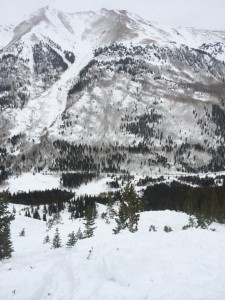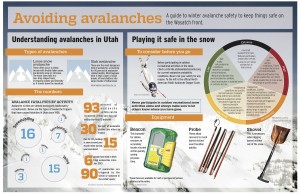The death of BYU student Ashleigh Cox on Feb. 9 has sparked questions about the safety of winter outdoor activities along the Wasatch Front.
According to members of the Utah County Sheriff’s Department search and rescue team, outdoor fatalities are preventable through education, proper training and preparation for poor weather conditions.
Recognizing avalanche conditions
Students should be aware of avalanche conditions before embarking on activities like skiing, snowshoeing or winter hiking.
“Students need to learn to check the avalanche danger before they go,” said Brian Hill, a member of the search and rescue team who teaches recreational management courses at BYU.

Students can check the forecast on utahavalanchecenter.org to check current conditions in the mountains regarding avalanche warnings, said Marci Adams, an adjunct professor teaching biology at BYU who is also a member of the search and rescue team.
“The site will tell you, elevation-wise, where to go. It’s pretty precise,” Adams said.
Utahavalanchecenter.org updates advisories for different regions of Utah from Logan to Provo to Moab.
There are five colors to distinguish among the different danger levels on the North American Public Avalanche danger scale, as seen on the graphic below.
The levels of danger:
Green is lowest on the scale with generally safe avalanche conditions according to avalanche.org. Yellow is moderate heightened avalanche conditions on specific terrain features with human-triggered avalanches possible. Orange is considerable danger with natural avalanches and human-triggered avalanches possible. Red is a high danger level and any traveling in a red zone is not recommended with large avalanches very likely. Black is extreme on the danger level and travel advice is to avoid all avalanche terrain.

Cox and her party of snowshoers were traveling through a red zone advisory on the day they were caught in a slab avalanche.
Hill had been training with members of the search and rescue team the same day Cox was snowshoeing.
“It’s ironic that we had been out training that very morning in avalanche rescue. We were up in Aspen Grove, but we stayed away from any place because the risks were so high, we ended up training in a flat field. We just stayed away from anywhere snow might come,” Hill said. “The conditions were so bad, and the risk was so high it could’ve happened anywhere. That’s why it’s better off not tempting fate.”
What to do if caught in an avalanche
What to do depends on whether snow covers the victim.
“Some of the kids who were with Ashleigh Cox were just surrounded by snow,” Hill said. “The snow is slushy when it’s moving. When it stops, it sets like concrete.”
Hill added if arms are caught in the snow, one won’t be able to dig out.
“There are a couple of things people say to do. One is that people will use a swimming motion. If you’re caught and have any control, you should try and avoid trees and large rocks. Half the people who die in avalanches are killed from the trauma from hitting things,” Hill said.
Suffocation is another way people die from avalanches, Hill said.
“Your chances are slim, but if you can get an air pocket … if they can get their hands around their face and build an air pocket, that might give them a little bit more of a chance,” Hill said.
In Cox’s case, she was caught face down in the stream under anywhere from 18 inches to two feet of snow. She had no chance of getting out, Hill said.
“You think it’s fluffy and light, but it’s not,” Adams said of the snow.
Essential avalanche survival gear
Chances of survival and rescue are higher if back-country enthusiasts have the proper gear.
“There are things you should have on your person if you’re going into that kind of country,” Adams said. “A shovel in case you’re able to dig your friend out. A probe, which is a really long tent pole, in essence, to use to find your friend. An electronic device called a beacon on you and on your friend. They talk to each other. You can find your friend, or your friend can find you.”
Avalanche beacons are turned on as people leave on outdoor trips. Beacons can be switched to a receive mode so search parties can find the signals of anyone lost in the snow.
All three pieces of gear can be rented at Outdoors Unlimited for $15 a day.
“Nowadays, you’ve got floats. An air device that you can pull the trigger and it will blow up like an air raft,” Adams said. This device increases the chances of those caught in an avalanches from being swept under.
The air devices will keep adventurers on top of the snow but will not prevent trauma of hitting large objects like trees, Adams said.
Avalanches not the only outdoor danger
Although temperatures may be warming up in the valley, BYU students often do not recognize that weather conditions in the mountains will be different.
“It’ll be warm and sunny down here in Provo and people will think, ‘Oh, it’s a good time to go and climb Timpanogos,'” Hill said. “One kid had frostbite on his feet. There’s still a lot of snow, and the runoff is very dangerous.”
Snow and ice will slide down the mountain sides, creating a chasm between the cliff face and ice forming a trap in which people cannot climb out of.
Adams added conditions will always be different due to the changes in elevation.
The risk of death and injury increases when students are not properly dressed and equipped, have no backup plan and do not let friends and family know where they will be going and when to expect their return, Hill said.




